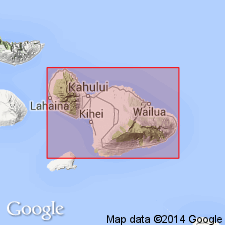
- Usage in publication:
-
- Ohia basalt*
- Modifications:
-
- Named
- Dominant lithology:
-
- Basalt
- AAPG geologic province:
-
- Maui
Summary:
Named from Ohia Spring which issues from it, Keanae Valley eastern Maui. Included as unit of Hana volcanic series. Below 600 ft confined to east side of Keanae Valley and filled small gulch cut into west edge of Pauwalu lava (new). It flowed through gap between Keanae and Wailuanui valleys and spread across fan of older alluvium to mouth of Wailuanui Stream. Composed of medium- to dark-gray olivine basalt containing rare phenocrysts of feldspar up to 8 mm long and few small phenocrysts of olivine. Exposed overlying alluvium in sea cliff along west side of Wailuanui Bay, one branch reaches sea between Pauwalu Point and Keanae village. Overlies Pauwalu basalt (new); underlies Keanae basalt (new) (both units of Hana volcanic series). Map shows middle(?) and late Pleistocene and Recent age.
Source: GNU records (USGS DDS-6; Menlo GNULEX).

- Usage in publication:
-
- Ohia basalt*
- Modifications:
-
- Age modified
- AAPG geologic province:
-
- Maui
Summary:
Type locality: Ohia Spring which issues from it in Keanae Valley [20 deg 51' 16"N, 156 deg 08' 43"w, Keanae 7.5' quad] northern shore of Island of Maui, HI. Is few tens of ft thick. Overlies Pauwalu basalt and older alluvium. Assigned Pleistocene(?) age.
Source: GNU records (USGS DDS-6; Menlo GNULEX).

- Usage in publication:
-
- Ohia Basalt†
- Modifications:
-
- Abandoned
- AAPG geologic province:
-
- Maui
Summary:
Ohia Basalt of Stearns and Macdonald (1942) abandoned as formally named unit and called Ohia flow, informal unit of Hana Volcanics. Hana Volcanics assigned Pleistocene(?) and Holocene age.
Source: GNU records (USGS DDS-6; Menlo GNULEX).
For more information, please contact Nancy Stamm, Geologic Names Committee Secretary.
Asterisk (*) indicates published by U.S. Geological Survey authors.
"No current usage" (†) implies that a name has been abandoned or has fallen into disuse. Former usage and, if known, replacement name given in parentheses ( ).
Slash (/) indicates name conflicts with nomenclatural guidelines (CSN, 1933; ACSN, 1961, 1970; NACSN, 1983, 2005, 2021). May be explained within brackets ([ ]).

